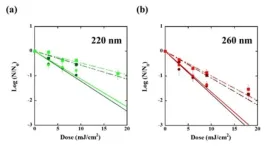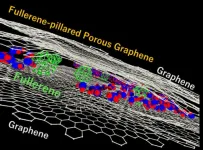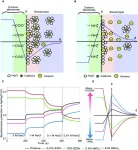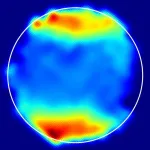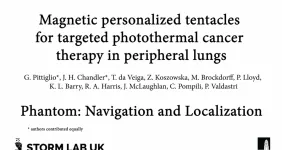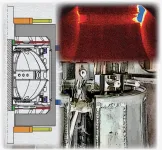(Press-News.org) The global outbreak of severe acute respiratory syndrome coronavirus 2 (SARS-CoV-2) and its new variants has created a need for effective disinfection technologies to protect against harmful pathogens. While vaccines offer some protection, their effectiveness against future variants is uncertain. Therefore, additional strategies are important during the pre-vaccine stage.
UV irradiation has lately emerged as a safe, effective, and convenient strategy to inactivate and eliminate disease-causing micro-organisms. The wavelength range of 200-235 nm, often referred to as far-UVC, is being increasingly investigated as a novel disinfection wavelength. Even though it has been shown to be harmless to mammalian cells due to the strong absorption effect of the stratum corneum layer, the safety of UV irradiation on mammalian cells is not well-established, and there are concerns that high levels of far-UVC light can cause damage to the skin cells. Further, available study data has significant inconsistencies that might be caused by the differences in both the strains of SARS-CoV-2 and experimental conditions such as the spectrum of the light sources. To address these issues, Prof. Takahiro Matsumoto from the Graduate School of Design and Architecture, Nagoya City University, along with his team, conducted systematic experiments using varying UV wavelengths without variance in other experimental conditions. The dedicated team of scientists included Prof. Makoto Tomita from Shizuoka University, Prof. Tadao Hasegawa from Nagoya City University, and Prof. Yasuhito Tanaka from Kumamoto University, among others. Their study was published online on 15th June, 2023 in Scientific Reports.
To explore the interaction of UV rays with two omicron variants of coronavirus, the team conducted a series of experiments. First, they isolated omicron BA.2 and BA.5 variants of SARS-CoV-2 from the infected cells (VeroE6/TMPRSS2). Next, they subjected the isolated omicron BA.2 and BA.5 variants to UV irradiation across a range of wavelengths, specifically ranging from 200 to 260 nm. For each wavelength, varying doses of UV irradiation, ranging from 0 to 18 mJ/cm2, were applied. The inactivation rate constant–which quantifies effectiveness of the treatment—was calculated by using two methods, TCID50 (tissue culture infectious dose) and qPCR (quantitative polymerase chain reaction).
The study showed that both omicron BA.2 and BA.5 variants have almost identical UV inactivation properties. Although the inactivation rates were highest at 260 nm, the rates obtained with 220 nm light were similar to those obtained with the former. The findings highlight the potential of far-UVC light as a safe germicidal option. "The comparable inactivation efficacy between 220 nm and 260 nm light suggests that far-UVC light could be a promising and safe approach to mitigate airborne virus transmission,” concludes Prof. Matsumoto.
Furthermore, it was found that the UV inactivation rate constants obtained in a liquid suspension were approximately 10 times lower than those previously obtained in an aerosol, suggesting the potential role of the Mie scattering effect in enhancing UV irradiance within aerosol droplets.
Additionally, the bacteria E. coli was used as a reference point to compare and understand the differences in inactivation and genome damage when compared to the SARS-CoV-2 omicron variants. The study found that, above 240 nm, both SARS-CoV-2 and E. coli exhibit similar sensitivities to UV light, indicating UV-induced inactivation primarily targets genes (DNA or RNA). However, below 240 nm, significant differences were observed, which can be attributed to the difference in thickness of the protein layer covering DNA or RNA. Also, the spectral sensitivities obtained through TCID50 assays and qPCR assays indicated correlation between the two methods.
This study provides valuable insights into the UV susceptibility of SARS-CoV-2 omicron variants. The observed similarities in inactivation efficacy between 220 nm and 260 nm light, in combination with aerosols, suggest the potential use of far-UVC light for preventing airborne virus transmission in a safe and practical manner. It is expected that, the results obtained here will pave way toward safe ultraviolet sterilization technologies in the near future.
END
UV disinfection in the treatment management of SARS-CoV-2 Omicron variants
Scientists investigate the inactivation efficacy of different UV wavelengths and assess the safety profile for effective management of COVID-19 risks
2023-07-27
ELSE PRESS RELEASES FROM THIS DATE:
Fullerene-pillared porous graphene with high water adsorption capacity
2023-07-27
Separation processes are essential in the purification and concentration of a target molecule during water purification, removal of pollutants, and heat pumping, accounting for 10–15% of global energy consumption. To make the separation processes more energy efficient, improvement in the design of porous materials is necessary. This could drastically reduce energy costs by about 40–70%. The primary approach to improving the separation performance is to precisely control the pore structure.
In this regard, ...
Tuning surface molecular design of porous carbon for blue energy harvesting
2023-07-27
Did you know rivers carry about 40 trillion metric tons of river water into the ocean every year? This meeting point, known as the estuary, holds great potential for electricity generation. Mixing the two types of water -- seawater and river water containing different salt concentrations -- releases a substantial amount of Gibbs free energy, which can be converted to electricity using semipermeable membranes. However, the performance of membranes has limited the economic viability of membrane-based approaches, leaving the vast potential of this naturally abundant energy source largely untapped.
To overcome the challenges associated with the membranes, researchers have developed membrane-free ...
New research reveals historic migration’s link to present-day implicit racial bias
2023-07-27
Roughly six million Black people moved away from the American South during the Great Migration between 1910 and 1970, hoping to escape racial violence and discrimination while pursuing economic and educational opportunities. Now, research has uncovered a link between this historic event with present-day inequalities and implicit biases.
In a new Social Psychological and Personality Science article, researchers report that current implicit bias among White people at the county-level is associated with the proportion of Black residents living in that county during the Great Migration (circa 1930). The research supports the Bias ...
Sri Lanka floods easier to predict with India weather tool
2023-07-27
Floods and landslides in Sri Lanka could be better predicted by applying weather forecasting techniques currently used in India, a study has found.
The new research has the potential to help communities better prepare for extreme rainfall in Sri Lanka. The South Asian island is extremely vulnerable to floods and landslides caused by heavy rainfall. In May 2017, more than 150 people were killed after Sri Lanka experienced flooding triggered by monsoon rains.
Led by Dr Akshay Deoras and published today (Thursday, 27 July) in Geophysical Research Letters, the study expands the ...
Study highlights importance of quality and potency of saw palmetto extracts in prostate health supplements
2023-07-27
A new study published in the Journal of Urology Open Plus reveals that 7 saw palmetto products met the identity and potency standards to effectively address urinary tract symptoms associated with an enlarged prostate. According to the lead author of the study, Dr. Bilal Chughtai, who is a board-certified urologist, of the 28 supplements included in the study, only six of the lipid extracts and one multi-active product were found to have the appropriate dosage of 320 milligrams of saw palmetto extract and the minimum 80% fatty acids clinically shown to address ...
New app developed at NYU Tandon School of Engineering promises to make navigating subway stations easier for people with blindness and low vision
2023-07-27
A new trip-planning app has shown encouraging results in improving navigation inside subway stations, according to a study published in IEEE Journal of Translational Engineering in Health and Medicine, promising the possibility of easier commutes for people who are blind and low-vision.
Designed by researchers at NYU Tandon School of Engineering and NYU Grossman School of Medicine, Commute Booster routes public-transportation users through the “middle mile” – the part of a journey inside subway stations or other similar transit hubs – in addition to the “first” and “last” miles that bring travelers to and from those hubs.
“The ...
New research shows potential role for mangos in supporting vascular health and antioxidant activities
2023-07-27
Boston - July 27, 2023 - Mangos are one of the most popular fruits1 in the world, grown in more than 100 countries2 globally and consumed by an extremely diverse population. Now, two new studies funded by the National Mango Board and presented as posters during the American Society for Nutrition’s Annual Conference (Nutrition 2023) show mangos may play a role in risk reductions for vascular issues while helping to improve antioxidant levels among relatively healthy adult men and women who are overweight ...
James Webb Space Telescope sees Jupiter moons in a new light
2023-07-27
With its sensitive infrared cameras and high-resolution spectrometer, the James Webb Space Telescope (JWST) is revealing new secrets of Jupiter's Galilean satellites, in particular Ganymede, the largest moon, and Io, the most volcanically active.
In two separate publications, astronomers who are part of JWST's Early Release Science program report the first detection of hydrogen peroxide on Ganymede and sulfurous fumes on Io, both the result of Jupiter's domineering influence.
"This ...
Tiny surgical robots could transform detection and treatment of cancers
2023-07-27
The ultra-soft tentacle, which measures just 2 millimetres in diameter and is controlled by magnets, can reach some of the smallest bronchial tubes and could transform the treatment of lung cancer.
It paves the way for a more accurate, tailored, and far less invasive approach to treatment and has been developed by engineers, scientists and clinicians based at the STORM Lab in Leeds.
The researchers tested the magnetic tentacle robot on the lungs of a cadaver and found that it can travel 37% deeper than the standard equipment and leads to less tissue damage.
The results ...
Fusion model hot off the wall
2023-07-27
Kyoto, Japan -- Humans may never be able to tame the Sun, but hydrogen plasma -- making up most of the Sun's interior -- can be confined in a magnetic field as part of fusion power generation: with a caveat.
The extremely high temperature plasmas, typically as high as 100 million degrees Celsius, confined in the tokamaks -- donut-shaped fusion reactors -- cause damage to the containment walls of these mega devices. Researchers inject hydrogen and inert gases near the device wall to cool the plasma by radiation and recombination, ...
LAST 30 PRESS RELEASES:
Tracing the quick synthesis of an industrially important catalyst
New software sheds light on cancer’s hidden genetic networks
UT Health San Antonio awarded $3 million in CPRIT grants to bolster cancer research and prevention efforts in South Texas
Third symposium spotlights global challenge of new contaminants in China’s fight against pollution
From straw to soil harmony: International team reveals how biochar supercharges carbon-smart farming
Myeloma: How AI is redrawing the map of cancer care
Manhattan E. Charurat, Ph.D., MHS invested as the Homer and Martha Gudelsky Distinguished Professor in Medicine at the University of Maryland School of Medicine
Insilico Medicine’s Pharma.AI Q4 Winter Launch Recap: Revolutionizing drug discovery with cutting-edge AI innovations, accelerating the path to pharmaceutical superintelligence
Nanoplastics have diet-dependent impacts on digestive system health
Brain neuron death occurs throughout life and increases with age, a natural human protein drug may halt neuron death in Alzheimer’s disease
SPIE and CLP announce the recipients of the 2025 Advanced Photonics Young Innovator Award
Lessons from the Caldor Fire’s Christmas Valley ‘Miracle’
Ant societies rose by trading individual protection for collective power
Research reveals how ancient viral DNA shapes early embryonic development
A molecular gatekeeper that controls protein synthesis
New ‘cloaking device’ concept to shield sensitive tech from magnetic fields
Researchers show impact of mountain building and climate change on alpine biodiversity
Study models the transition from Neanderthals to modern humans in Europe
University of Phoenix College of Doctoral Studies releases white paper on AI-driven skilling to reduce burnout and restore worker autonomy
AIs fail at the game of visual “telephone”
The levers for a sustainable food system
Potential changes in US homelessness by ending federal support for housing first programs
Vulnerability of large language models to prompt injection when providing medical advice
Researchers develop new system for high-energy-density, long-life, multi-electron transfer bromine-based flow batteries
Ending federal support for housing first programs could increase U.S. homelessness by 5% in one year, new JAMA study finds
New research uncovers molecular ‘safety switch’ shielding cancers from immune attack
Bacteria resisting viral infection can still sink carbon to ocean floor
Younger biological age may increase depression risk in older women during COVID-19
Bharat Innovates 2026 National Basecamp Showcases India’s Most Promising Deep-Tech Ventures
Here’s what determines whether your income level rises or falls
[Press-News.org] UV disinfection in the treatment management of SARS-CoV-2 Omicron variantsScientists investigate the inactivation efficacy of different UV wavelengths and assess the safety profile for effective management of COVID-19 risks
